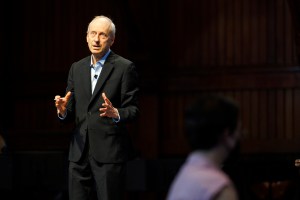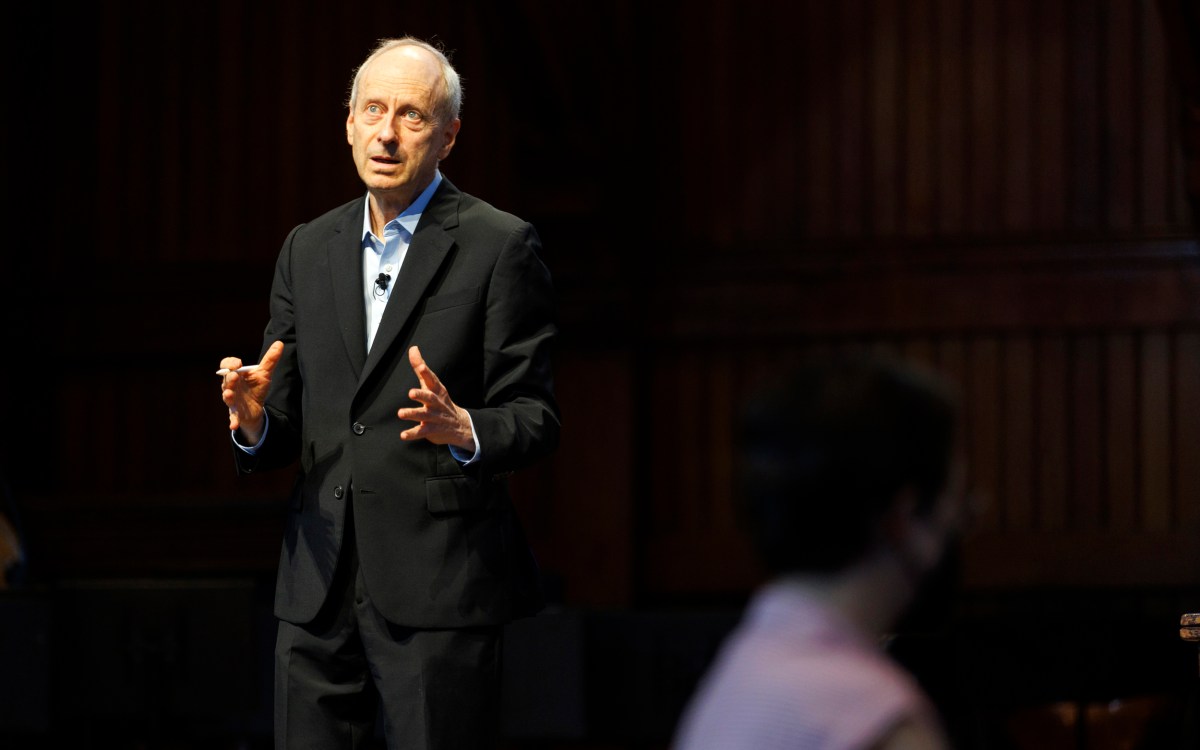GSD lecture and panel address ‘Designing for Sustainability’
Interest in green building is high at the Harvard Graduate School of Design (GSD), judging by the attendance at a lecture Tuesday (Oct. 21) in the Stubbins Room at Gund Hall. “Designing for Sustainability” was part of the popular and event-packed sustainability celebration instituted this year by Harvard President Drew Faust.
Participants in the panel discussion were introduced by moderator Jerold Kayden, co-chair of the Department of Urban Planning and Design, who noted that analyses like those taking place around the University indicate that we still have a somewhat undefined idea of what a sustainable community really is. “The word ‘sustainability’ is loaded with so much baggage,” he said. “Should it have the full range of community issues within it that we might say represent a good community rather than just a sustainable community? Are the two different?”
Should discussions of the social aspects of diversity, for example, come under the umbrella of sustainability in community design? “I’m not suggesting they shouldn’t, or that one definition is axiomatically better than the other,” Kayden continued, “just that we need to be mindful of what is included. How all-encompassing is the term ‘sustainability’ before it ends up being overloaded, being all things to all people and thus losing some of the precision it might otherwise have?”
The breadth of the presentations — one micro and one macro — suggested that the term is a wide-ranging one.
Christoph Reinhart, an associate professor of architectural technology, spoke in detail about “daylighting,” or the use of various design techniques to enhance the presence of natural light in a building, creating not only a brighter, happier interior, but also a more energy-efficient one. Reinhart presented several rules of thumb regarding the technicalities of daylighting and presented several ongoing research projects, including one that examines retrofitting measures for classrooms in aging public schools in New York City. Another looks at whether graphical user interfaces have matured to the point where designers can use them to build meaningful and accurate models that support informed retrofitting measures.
“What’s really important for me is trying to foster research right now in the Advanced Studies Program in the Graduate School of Design,” Reinhart said, noting that just two months ago he helped establish a GSD area of concentration for sustainability that focuses on evidence-based design and “thinking beyond” LEED certification.
The second talk of the day was co-presented by Christian Werthmann, associate professor and program director in landscape architecture, and Thomas Schroepfer, an assistant professor of architecture. They spoke about TransUrban, an ongoing interdisciplinary design study on exemplary environmental city developments in Europe. Their first case study, presented by Schroepfer, was on Vauban, a former barracks site near Freiburg, Germany, that now comprises more than 2,000 homes and workplaces. Citizens participated in the planning of Vauban; prime concerns included reduction of car use, increase in community spaces and green corridors, and energy-efficient buildings.
The second case study, presented by Werthmann, was on solarCity, a public housing initiative for 3,000 people near Linz, Austria. SolarCity aims to minimize its environmental impact through self-sufficient energy generation and onsite waste processing. Werthmann and Schroepfer outlined the pros and cons in each development (one con, for solarCity: an “overabundance” of open space), and made several conclusions.
First, they maintained, though there are tools to measure individual building performance, ways of measuring sustainable urban development as a comprehensive framework are still in their formative stages. Second, good architecture and urban design are “the glue” to sustainable communities. Finally, the net densities of both developments are relatively low, with a generous 50 to 100 persons per hectare. Can such developments have increased capacities and still retain their high-quality environments? The two men suggested that a population of up to 5,000 — about the size of a traditional neighborhood — may be ideal for population retention and “stakeholding” in the community.
“Despite the open questions of connectivity with surrounding communities and the lack of urban quality compared with city core areas,” Werthmann concluded, “the case studies of Vauban and solarCity allow us a glimpse of possible alternatives to urban neighborhood development, which allows flexibility for change without depleting the resources for generations to come.”
As Kayden said after the discussion, a quick and easy definition of sustainability is simply “here today, here tomorrow.”





